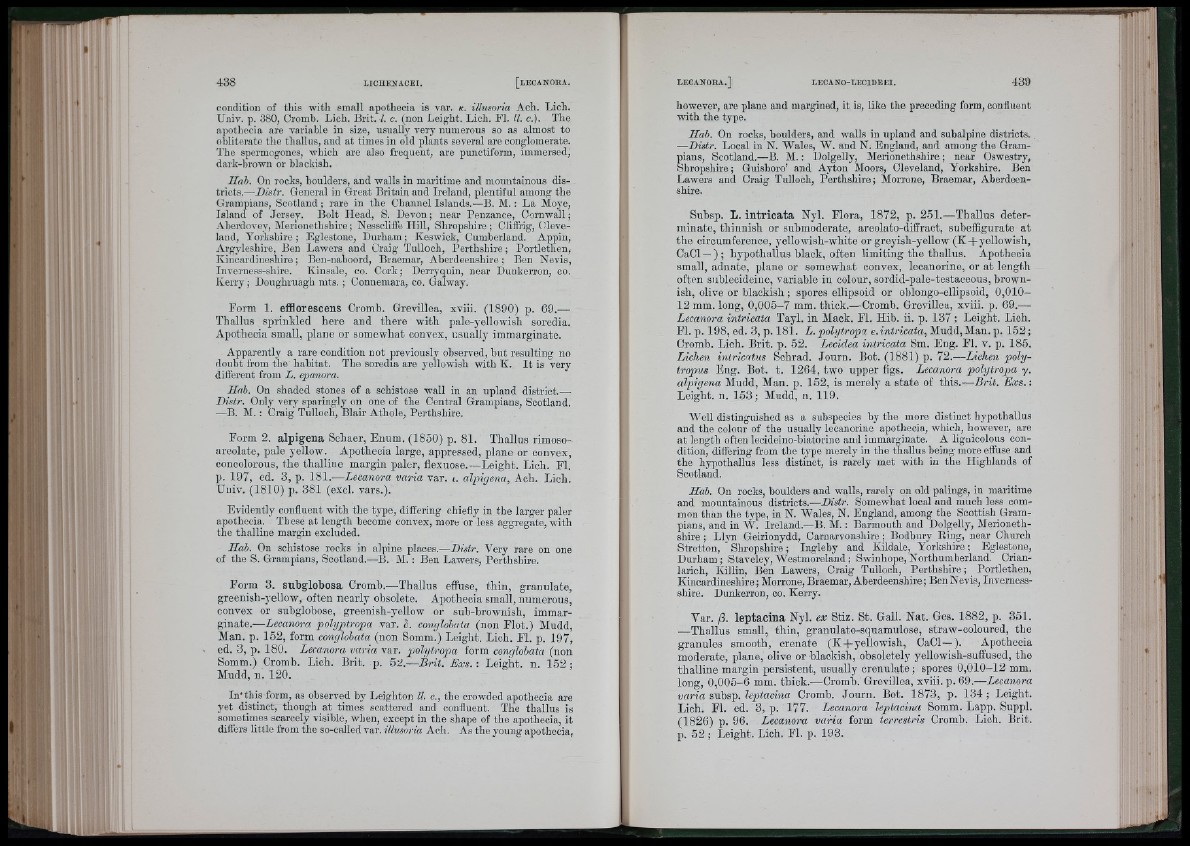
condition of tliis witli small apothecia is var. k. illusoria Ach. Lich.
Univ. p. 380, Cromb. Lich. Brit. I. c. (non Leight. Lich. I ’l. U. c.). The
apothecia are variable in size, usually very numerous so as almost to
obliterate the thallus, and at times in old plants several are conglomerate.
The spermogones, which are also frequent, are punetlform, immersed,
dark-brown or blackish.
Ilah. On rocks, boulders, and walls in maritime and mountainous districts.—
Distr. General in Great Britain and Ireland, plentiful among the
Grampians, Scotland ; rare in the Channel Islands.—B. M. ; La Moye,
Island of Jersey. Bolt Head, S. Devon ; near Penzance, Cornwall ;
Aberdovey, Alerionethshire ; Nessclifie Hill, Shropshire; Cliffi’ig, Cleveland,
Yorkshire ; Eglestone, Durham ; Keswick, Cumberland. Appin,
Argylesliire, Ben Lawers and Craig Tulloch, Perthshire ; Portlethen,
Kincardineshire ; Ben-naboord, Braemar, Aberdeeushire ; Ben Nevis,
Inverness-shire. Kinsale, co. Cork ; Derryquin, near Dunkerron, co.
Kerry ; Doughruagh mts. ; Connemara, co. Galway.
Form I. efflorescens Cromb. Grevillea, xviii. (1800) p. 69.—
Tballus sprinkled here and th ere with pale-yellowish soredia.
Apotbecia small, plane or somewhat convex, usually immarginate.
Apparently a rare condition not previously observed, but resulting no
doubt from the habitat. The soredia are yellowish with K. I t is very
différent from L. epanora.
Hnb. On shaded stones of a schistose wall in an upland district.—
Distr. Only very sparingly on one of the Central Grampians, Scotland.
—B. AI. ; Craig Tulloch, Blair Athole, Perthshire.
Form 2. alpígena Schaer, Enum. (1850) p. 81. Thallus rimoso-
areolate, pale yellow. Apotbecia large, appressed, plane or convex,
concolorous, the thallino margin paler, flexuose.—Leight. Licb. Fl.
p. 197, ed. 3, p. 181.— Lecanora varia var. i. alpígena, Acb. Lich.
Univ. (1810) p. 381 (excl. vars.).
Evidently confluent with tbe type, differing cbiefly in the larger paler
apotliecia. These at length become convex, more or less aggregate, with
the thalline margin excluded.
Hab. On schistose rocks in alpine places.—Distr. Very rare on one
of the S. Grampians, Scotland.—B. AI. : Ben Lawers, Perthshire.
Form 3. subglobosa Cromb.—Thallus effuse, th in , granulate,
greenish-yellow, often nearly obsolete. Apothecia small, numerous,
convex or subglobose, greenish-yellow or sub-brownish, immarginate.—
Lecanora polyptropa var. J. conglóbala (non F lo t.) Mudd,
Man. p. 152, form conglóbala (non Somm.) Leigbt. Lioh. F l. p. 197,
ed. 3, p. 180. Lecanora varia var. p o lytropa form conglóbala (non
Somm.) Cromb. Lich. Brit. p. 52.—È r it. Eæs. : Leight. n. 152 ;
Mndd, n. 120.
In 'th is form, as observed by Leighton ll. c., the crowded apothecia are
yet distinct, though at times scattered and confluent. Tlie thallus is
sometimes scarcely visible, wlien, except in the shape of the apothecia, it
differs little from the so-called var. illusoria Ach, As the young apothecia.
however, are plane and margined, it is, like the preceding form, confluent
with the type.
Hab. On rocks, boulders, and walls in upland and subalpine districts.
—Distr. Local in N. Wales, W. aud N. England, and among the Grampians,
Scotland.—B. AI.: Dolgelly, Merionethshire; near Oswestry,
Shropshire; Guisboro’ and Ayton Moors, Cleveland, Yorkshire. Ben
Lawers and Craig Tulloch, Perthshire; Morrone, Braemar, Aberdeenshire.
Subsp. L. intricata Nyl. Flora, 1872, p. 251.—Tballus determinate,
tbinnisb or submoderate, areolato-diffract, subeffigurate a t
th e circumference, yellowish-white or greyish-yellow (K + yellowish,
CaCl — ) ; hypothallus black, often limiting tb e tballus. Apotheoia
small, adnate, plane or somewhat convex, lecanorine, or a t length
often sublecideine, variable in colour, sordid-pale-testaceous, brownish,
olive or b la ck ish ; spores ellipsoid or oblongo-ellipsoid, 0 ,0 1 0 -
12 mm. long, 0,005-7 mm. thiok.—Cromb. Grovillea, xviii. p. 69.—
Lecanora intricata Tayl. in Mack. Fl. Hib. ii. p. 137; Leight. Lioh.
Fl. p. 198, ed. 3, p. 181. L .polytropa e.intricata, Aludd,Man. p. 152;
Cromb. Lich. Brit. p. 52. Lecidea intricata Sm. Eng. F l. v. p. 185.
Lichen intricatus Sobrad. Jo u rn . Bot. (1881) p. 72.— Liehen p o ly tropus
Eng. Bot. t. 1264, two upper figs. Lecanora polytropa y.
alpígena Mudd, Man. p. 152, is merely a sta te of tbis.—Brit. E.vs. :
Leigbt. n. 153; Mudd, n. 119.
Well distinguished as a subspecies by the more distinct hypothallus
and the colour of the usually lecanorine apothecia, which, however, are
a t length often lecideino-biatorine and immarginate. A lignicolous condition,
differing from the type merely in the thallus beiug more effuse and
the hypothallus less distinct, is rarely met with iu the Highlands of
Scotland.
Hab. On rocks, boulders and walls, rarely on old palings, in maritime
and mountainous distriets.—Distr. Somewhat local aud much less common
than the type, in N. Wales, N. England, among the Scottish Grampians,
and in W. Ireland.—B. AI.; Barmouth and Dolgelly, Alerionethshire
; Llyn Geirionydd, Carnarvonshire ; Bodbury King, near Church
Stretton, Shropshire; Ingleby and Kildale, Yorkshire; Eglestone,
Durham; Staveley, Westmoreland ; Swinhope, Northumberland. Crianlarich,
Killin, Ben Lawers, Craig Tulloch, Pe rthshire ; _ Portlethen,
Kincardineshire; Alorrone, Braemar, Aberdeenshire; Ben Nevis, Inverness-
shire. Dunkerron, co. Kerry.
Var. p. leptacina Nyl. ex Stiz. St. Gall. Nat. Ges. 1882, p. 351.
—Tballus small, th in , granulato-squamulose, straw-coloured, the
granules smooth, crenate (K + yeliowish, CaCl — ). Apothecia
moderate, plane, olive or blackish, obsoletely yeUowish-suffused, the
th allin e margin persistent, usually c ren u la te ; spores 0 ,0 1 0 -1 2 mm.
long, 0,005-6 mm. thick.-—Cromb. Grevillea, xviii. p. 69.— Lecanora
varia subsp. leptacina Cromb. Jo u rn . Bot. 1873, p. 134 ; Loight.
Lioh. F l. ed. 3, p. 177. Lecanora leptacina Somm. Lapp. Suppl.
(1826) p. 96. Lecanora varia form terrestris Cromb. Lioh. Brit,
p. 52 ; Leight. Lioh. Fl. p. 193.